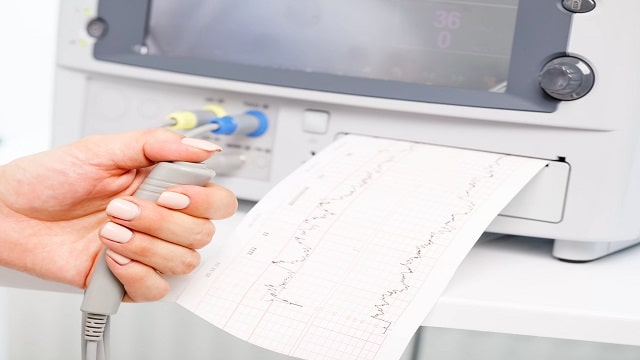Cardiotocography (CTG) is a tool used by obstetricians to monitor the heart rate and uterine contractions while the baby is in the womb. Typically, a baby in the womb has a heart rate between 110 and 160 beats per minute which increases when the baby moves.
This baby’s heartbeat check indirectly becomes a way to know if the baby is getting enough oxygen from the placenta. This test looks at how the baby’s heartbeat is affected by contractions. This tool is used when the pregnant mother enters the third trimester and is useful for detecting whether there are any disorders or not in the baby before or during labor.
Therefore, when there is a change in the fetal heart rate or contractions occur, the obstetrician together with the midwife are ready to provide appropriate action to help the fetus in the womb.
Are There Any Side Effects?
Cardiotocography does not use radiation, so this examination is very safe for pregnant women. This examination does not trigger any side effects on the mother or the baby in the womb.
When Should You Do a Cardiotocography Test?
Cardiotocography is performed when entering the third trimester. In addition, if the risk factors (as mentioned above) in the baby are quite worrying, then the doctor also asks the pregnant woman to do this test often.
Before performing the CTG procedure, the doctor will usually ask the mother to eat or drink something. Usually, by consuming food or drink, this makes the baby move more often.
How to Perform a Cardiotocography Test?
Cardiotocography is shaped like two small plates that are attached to the surface of the abdomen using an elastic belt that is looped around the pregnant woman’s abdomen. One plate measures the fetal heart rate, while the other measures the pressure on the abdomen.
Pregnant women must remain sitting or lying down during the CTG examination process. This examination can last between 20 to 60 minutes. That way, this tool is able to show when the pregnant woman experiences contractions and each contraction can be estimated in strength.
As with an ultrasound examination, before the CTG device is installed, gel needs to be applied to the surface of the pregnant woman’s stomach so that the signal can be captured properly. This belt is then connected to a machine that translates the signals received by the plate. During the procedure, the mother will be advised to sit in a recliner or lie on her left side.
Why Perform a Cardiotocography Test?
Medical personnel generally do not ask pregnant women to check their pregnancy using CTG if there are no risk factors or certain disorders in pregnancy and childbirth. Doctors will ask pregnant women to have CTG in the third trimester if they have the following conditions:
- The mother feels that the baby’s movements in the womb slow down or become irregular, this condition is suspected to occur because there is a problem with the placenta which limits blood flow to the baby.
- The baby has a very low birth weight or weight that is not in accordance with gestational age.
- The mother has low levels of amniotic fluid.
- Mother is pregnant with twins.
- Mother suffers from diabetes or hypertension.
- Having a high fever,
- There is bleeding during childbirth.
- Having infections such as HIV or hepatitis B and C.
- Breech pregnancy.
- Water breaks early.
- The pregnancy has passed the estimated due date.
- Have had a miscarriage or stillbirth in a previous pregnancy.
CTG can be performed to measure Braxton Hicks or false contractions and to anticipate real contractions in pregnant women who have passed the third trimester of pregnancy but have not yet given birth.
How Does Cardiotocography Work?
The CTG machine produces results in the form of graphs according to the fetal heart rate and uterine contractions. The results of the examination can be categorized as reactive and nonreactive. It is called non-reactive if the fetal heart rate does not increase after it moves, and reactive if the heart rate increases after it moves.
However, a non-reactive result does not always indicate a problem. It could be that the baby is in a deep sleep when the test is performed, so the doctor will try the test after asking the pregnant woman to move or using a fetal acoustic stimulator to wake the baby. If the result is still non-reactive, the doctor may ask to do the test again after an hour.
If the second CTG shows that the baby is still not responding well or the heart rate is not as it should be, the doctor will refer the pregnant woman for an ultrasound scan to assess the baby’s biophysical profile.
A biophysical profile will determine the condition of the baby and measure it based on movement, breathing, reactions, and muscle tone. If the baby shows poor results, the doctor may recommend early delivery.
The biophysical profile test combines a non-stress test with an ultrasound. There are several things to look for when doing this test, such as body movements, muscle tone, breathing movements, the amount of amniotic fluid surrounding it, and heart rate.
The test results will show whether the baby is getting the oxygen intake that suits his needs or not. Each of the things that are considered will be given an assessment. In general, a score of 8-10 means normal, 6 is considered the normal limit, while if the value is below 6 it is a worrying sign. So the doctor must take appropriate action on this condition.
Where to Do Cardiotocography Test?
This test can only be done with a referral from a doctor or midwife. If you are planning to do a cardiotocography test, immediately make an appointment with a doctor at the hospital of your choice here.
